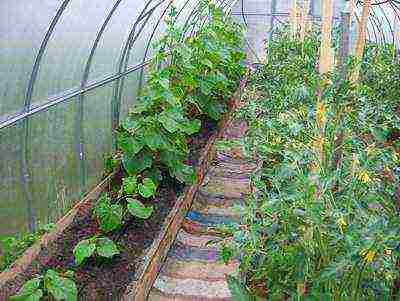Content [show]
Growing various vegetable, green and berry crops, as well as mushrooms in the basement is an extremely interesting and profitable activity that allows you to effectively use the auxiliary premises. At the end of the 19th century, the first experiments were carried out. In those days, gas burners and kerosene lamps were used for lighting.
When the weather is cold outside and nothing grows in the garden, you should pay attention to the cellar, which can be used for your own purposes, because there is a constant above-zero temperature all year round. Sometimes the most unexpected cultures are cultivated in the basement, many do not even suspect about such a possibility.
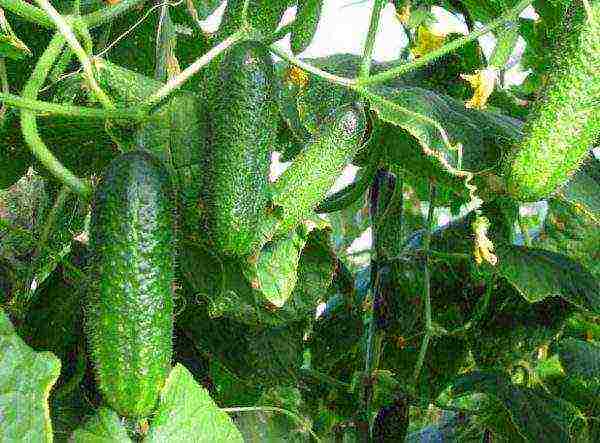
Advantages, disadvantages and features of basement growing
Proper use of even a small basement will allow you to grow a good harvest of vegetables for your own needs and even for sale. The main feature is the presence of an insulated basement, in which the temperature does not drop below 0 ° C, which is almost always possible. This will not require any special costs.
The advantages of basement cultivation include:
- By creating the right conditions for growing cucumbers in the basement and taking proper care of the plants, their yields are much higher than those of conventionally grown vegetables. It is estimated that from 1 m² of usable area you can get up to 60 kg of tomatoes and about 35 kg of cucumbers.
- There is an increased content of vitamin C in vegetables grown underground.
- The crop can be harvested all year round.
- Cellar seedlings grow faster. Cucumber reaches a state where it can be planted 6-7 days earlier than greenhouse plants. This leads to the fact that after 7-8 weeks you can start harvesting.
Growing cucumbers in a basement is more cost effective than growing cucumbers in heated greenhouses. All costs are reduced to paying for the electricity spent on lighting plantings in the basement. This is the only significant disadvantage inherent in basement growing.
Due to the difficulty of delivering normal soil, most often the cultivation in the basement takes place using the hydroponic method. In this case, the grown plants receive nutrition not from the soil, but from a special substrate, to which various organic and mineral substances are added, as well as a set of necessary microelements.
Diseases of cucumbers in the basement are practically excluded, since it is difficult for spores of fungal infections to appear and develop in the absence of land (where they most often persist). In addition, thorough disinfection of the premises is carried out in advance. This method can be used to grow not only cucumbers in the basement of a private house, but also other crops, and even animals.

What can be grown in the basement of a private house?
Before starting work, it is necessary to carry out a number of preparatory work. The main requirements for a cellar or basement are as follows:
- Tightness. It is necessary to exclude the possibility of water seepage into the basement (melt, ground, rain, etc.).
- The temperature must not drop below zero values.
- The room should be free of pests, rodents (rats, mice, moles, etc.).
- Fungal infections are categorically excluded.
In order to ensure tightness, a complex of works is being carried out to equip the basement waterproofing. For this, the surfaces are covered with bitumen-polymer mastic. All cracks must first be repaired. It is recommended to carry out additional insulation of the room with the help of polystyrene, which is subsequently covered with a special reinforcement mesh and a vapor barrier membrane. The basement must be disinfected from insects and mold using specialized compounds (solution of potassium permanganate, copper sulfate, lime, etc.).
Poisoned baits, traps, mouse traps, special smoke bombs, etc. are used to protect against rodents. The most important condition for the success of the entire event is the organization of a ventilation system so that the basement has the right microclimate with the required humidity indicators. If necessary, install special exhaust equipment. Ventilation openings are advised to be tightened with a mesh with a fine mesh, which will prevent the entry of insects and small animals.
But at the same time, there should be no drafts in the basement, which have an extremely negative effect on the growth of plants. The required temperature is created by connecting various heating devices (heat gun, heaters, etc.). The importance of lighting can hardly be overestimated, since there is simply no natural light in the basement. Plants will need to create a full day of light for proper growth. Artificial lighting mode is provided with the help of LED fluorescent lamps and special phytolamps that do not heat up.
The duration of the daily work of lighting devices depends on what to grow in the basement. Tomatoes need a day of light lasting at least 12 hours, cucumbers will need 10 hours, and for strawberries, lighting for 16-18 hours will be optimal.
The characteristics of the conditions created in the basement are determined by the requirements of the crop that is planned to be grown. There are many options for this, but the most popular for cultivation in the basement are:
- mushrooms (sometimes porcini, honey agarics or shiitake, but most often champignons and oyster mushrooms);
- vegetable crops (tomatoes, cucumbers);
- green crops (dill, parsley, onion, chicory salad);
- strawberries and strawberries;
- various flower cultures;
- fish, crayfish.
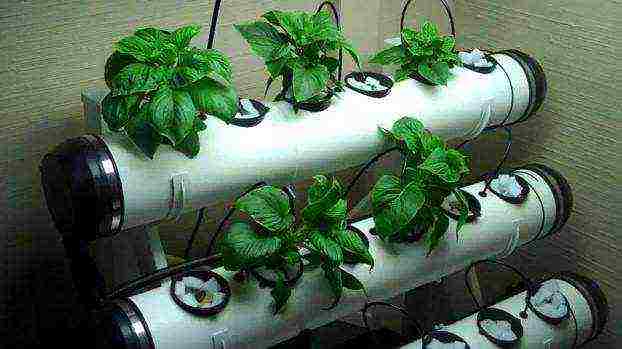
Seedlings of berries and other plants
For the basement cultivation of strawberries, it is necessary, among other conditions, to create the required temperature regime. The daytime temperature in the basement should be about + 25 ° C, and the nighttime temperature should not fall below + 16… + 18 ° C. You can grow this berry culture in the basement using the traditional method. For planting, use an earthen substrate, adding a little sand to it.
It is necessary to study all the rules for caring for this crop. An important component is regular planting feeding:
- During active growth, strawberries are fed with nitroammophos (10 g per 1 bucket of water) or organic matter (mullein solution in a ratio of 1:10, chicken manure infusion - 1:12), 0.5 liters per 1 bush.
- During the period of bud formation and flowering, the culture is fed with potash fertilizers: potassium nitrate (10 g per 10 l), ash. Spraying with a boric acid solution (2 g per 10 l) will be beneficial.
- At the end of the harvest, the plantings in the cellar are fertilized with ash (1 glass per 10 l) or mineral complexes (Agricola fertilizer)
In basements, hydroponics are used predominantly. There are several modifications of this method:
- Drip system. Seedlings are planted in a substrate (coconut, expanded clay, gravel, mineral wool).The nutrient solution is continuously supplied to the plant roots using droppers (perforated tubes). The simplest and most common option.
- A system with a useful layer. The nutrient composition is constantly pumped into a container, above which pots with seedlings are located in a plastic tray. The root system gradually grows and is immersed in a useful liquid.
- Aquaponics. The bushes are planted in bowls with a mixture of vermiculite and perlite, then placed on a piece of foam floating in the nutrient composition or on the lid of a vessel filled with the same composition.
- Aeroponics. The roots of plants planted in mineral wool receive nutrition from an artificially created sprayed mist with useful substances.
- Flooding method. The root system is periodically immersed in a nutrient solution at a fixed interval (set by a timer). Strawberries can be planted in moisture-absorbing material, but can also be grown without it.
After choosing the growing method and preparing the necessary equipment, they begin the selection and preparation of strawberry seedlings. It is harvested in early autumn or at the very end of summer. You can buy in the nursery or take it on your own plot. A prerequisite for the competent cultivation of strawberries in the cellar or basement is the placement of young plants for some time in extreme cold (in the freezer) to simulate winter sleep.
It is preferable to grow seedlings with your own hands from seeds. Seed material is sown in a bowl with a moist earthy substrate and sprinkled with a thin layer of earth. Seeds will germinate in a constantly moist soil and sufficient illumination, but the germination rate will be low - no more than 50%. Seedlings dive after the formation of a good root system at a distance of 5 cm from each other in a checkerboard pattern.
After 6 weeks, the seedlings are dived again, now after 10 cm. After a few more weeks, the plants are transplanted to a permanent place. Strawberry beds are renewed annually, using young rosettes for this. When the required growing conditions are created, strawberries give an extremely bountiful harvest that does not require much effort in automating the process.
Various green crops (dill, parsley, etc.) and flowers are grown in a similar way. A popular method of growing onions on a feather in the basement. Large quantities of sand are poured into flat containers and filled with water until completely wet. Then the onion heads are planted. After 10-12 days, the green mass can be cut off. Vegetables can be grown in the basement in the traditional way, using a mixture of soil and peat.
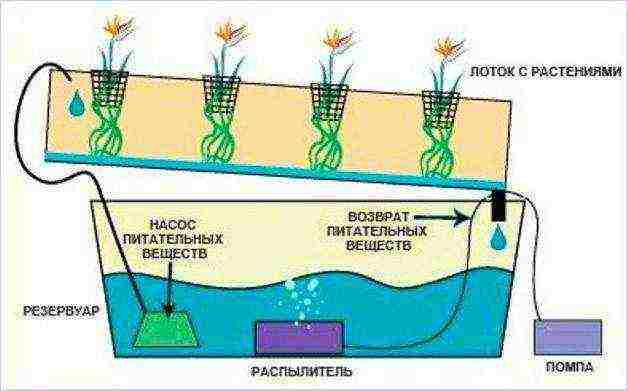
Vegetables
The most popular and common method for growing cucumbers and tomatoes in the basement is the hydroponic method. It allows you to achieve good yields. With this method, the usual earthen substrate is replaced with mineral wool, sand, expanded clay, gravel, perlite, etc. When using the hydroponic method, a solution of various mineral salts (calcium, potassium, manganese, phosphorus, zinc, sulfur, etc.) acts as a nutrient medium. ...
Growing cucumbers in the basement in winter comes down to the following steps:
- Germination of seeds. For this, special cassettes with corks made of mineral wool are used. A cucumber seed is placed in the center of each nutritious cork. Sprinkle on top with a small layer of vermiculite to maintain constant humidity. For 2-3 days, the cassettes are covered with glass or plastic wrap. The temperature at this time must be maintained within + 23 ... + 25 ° C.
- Transplanting seedlings. After about 7-8 days, the grown seedlings are carefully rolled together with a cork into special mineral wool cubes (they have ready-made holes), which are also saturated with a useful mineral solution.
- Transplanting. After 6-8 weeks from the time of planting, the seedlings are transplanted into mineral wool mats saturated with a nutrient composition.Drainage holes are made in the mats. When the roots germinate, the temperature is lowered to + 21 ° C.
With the beginning of flowering and the formation of the ovary, you need to remove all flowers up to 5 leaves, until the first cucumber grows. Lateral shoots are removed up to 7 leaves so that the bush develops evenly and continuously.
In the process of growing vegetables in the basement, the concentration of the nutrient solution and its mineral composition change depending on the phase of plant development. In the case of drip irrigation through the mats, it starts 2 hours after the lamps are turned on and stops about 1.5-2 hours before the lighting is turned off. It is necessary to constantly monitor the pH level (no more than 6.2) and the indicators of the nutrient solution during fruiting.
The requirements for the basement for growing cucumbers are to comply with the following indicators:
- humidity in the basement should not exceed 70-80%;
- the temperature is maintained at about + 22 ... + 24 ° C;
- when these temperature indicators are exceeded, the room is ventilated.
Cucumbers are grown hydroponically in the basement for no more than 3 months. Approximately 1.5-2 weeks before this period, you need to prepare a fresh batch of seedlings.
Not all varieties of cucumbers are suitable for this method. It is preferable to choose self-pollinating varieties for the basement (you can buy them in specialized stores), such as Marfinsky, German F1, Teplichny 40, Alma-Atinsky 1, VIR 1, etc. Tomatoes are better for taking early ripening periods.

Mushrooms
In your own basement, it is enough to simply arrange a home mushroom farm that does not require vigilant attention. The simplest and best option for home cultivation are mushrooms and oyster mushrooms.
The technology for growing in the basement is as follows:
- Substrate preparation. The composition is purchased in specialized stores. But you can do it yourself. It is prepared about 25-30 days before planting the mycelium from straw, horse manure, urea, chalk, gypsum, superphosphates and ammonium-containing fertilizers. The previously soaked straw is shifted with layers of manure, then mixed. The remaining ingredients are added at intervals of 3-4 days. When the temperature of the substrate is about + 23 ... + 25 ° C, it is placed in the basement for planting.
- Planting mycelium. It is grown sterile and sold in stores. It comes in compost and grain form. Compost mycelium is planted in pits made in the laid substrate, about 5 cm deep and 15-20 cm apart. Then it is sprinkled and poured with lukewarm water. Grain mycelium just needs to be evenly spread over the surface of the garden.
- Care. The optimum temperature in the basement during the formation of mycelium should be maintained within the range of + 22 ... + 27 ° C. After the appearance of the first mushroom filaments, after about 14-15 days, the temperature indicators are reduced to + 12 ... + 15 ° C. After that, the plantings are covered with a mixture of soil with peat and limestone in a ratio of 4: 5: 1. For 10-15 days, the surface is covered with a film and regularly sprayed with warm water. Then the humidification is stopped so as not to cause rotting of the mycelium.
- Harvesting. The first crop can be harvested 3-4 months after planting the mycelium. Then the fruiting waves will be repeated at intervals of 2.5-3 months. Mushrooms need to be carefully twisted, and the vacant space should be covered with a substrate. At the end of each wave, the mycelium in the basement is fed with a superphosphate solution.
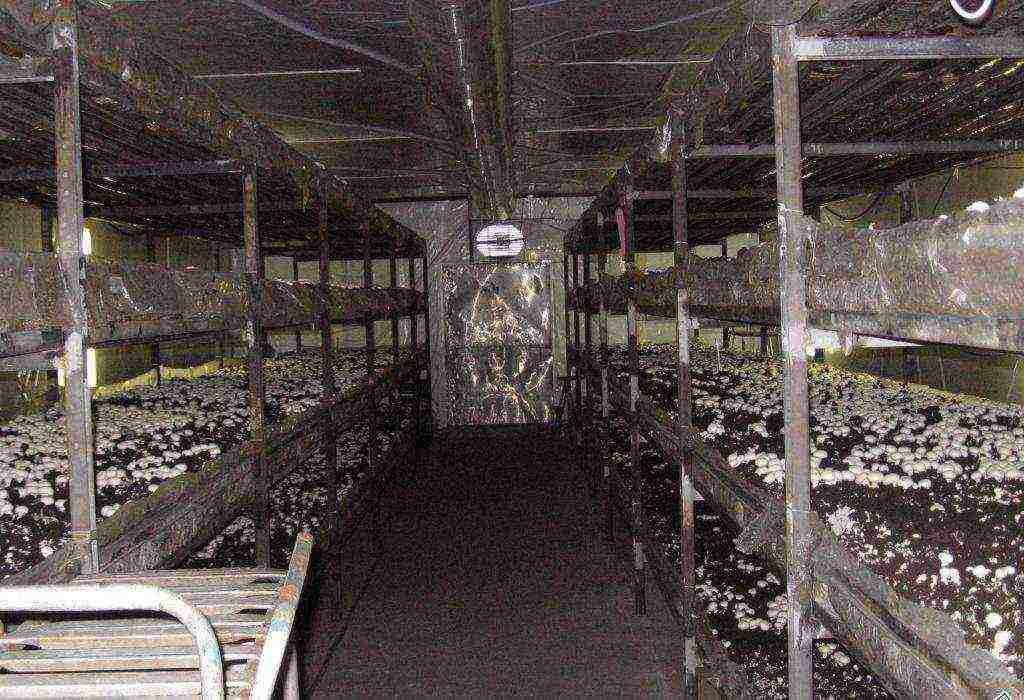
Fish and crayfish
Basement fish and invertebrate farming is exotic, complex and quite expensive. This process will require theoretical training in order to gain knowledge about their conditions of maintenance, habits, feeding needs and life cycles.
The basement room must be properly prepared. If in winter the temperature does not drop below + 5 ... + 7 ° C, then the room may not be additionally insulated.There are a number of special requirements for a communications device:
- you will need to install a closed-loop water supply system in the basement;
- it is necessary to use special compressors for water aeration (oxygenation);
- install water heaters;
- be sure to use filters for cleaning.
You can breed fish of different breeds (crucian carp, carp, carp, sturgeon, etc.) and crustaceans in the basement.
In the basement, containers with water are installed, the volume of which is determined by the species of fish (crayfish) and its quantity. Adults are kept separately from fry in different containers, because large specimens can eat small ones. Particular attention should be paid to water quality, since fish are extremely sensitive to this indicator. For crayfish, the deterioration in quality characteristics is not so destructive.
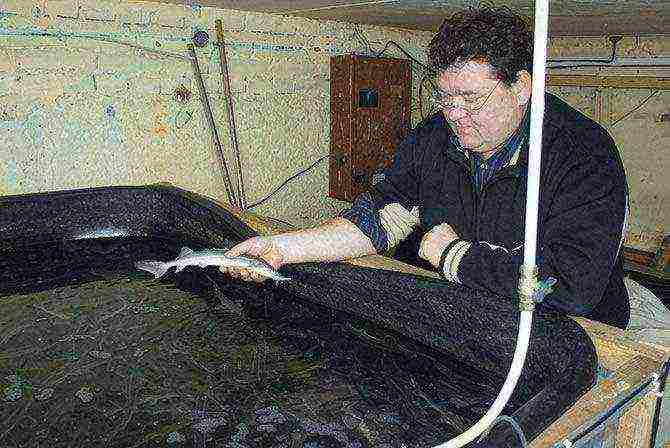
How to deal with rodents and other pests?
It is extremely important to fight mice, rats, insects and other pests in the basement, since they can cause great damage to plantings. Mousetraps are installed in the basement against rodents and poisonous baits are laid out. For these small animals, odors from cats are extremely unpleasant.
Treatments with special chemical agents will protect against insects. You can use folk methods. Slugs are caught in traps made of wet rags, and then collected by hand. Effectively sprinkle the floor in the basement with mustard, slaked lime, chalk or ash.
Conclusion
Before taking on the basement growing of vegetables or mushrooms (especially fish) at home, everything must be weighed and calculated in advance. It will not always be economically viable. The priority will be to get your own fresh produce in the basement for several years and all year round without interruption.

Growing strawberries in a cellar
A cellar is a room suitable not only for storing crops, but you can grow strawberries and many other berries and vegetables in it. When cultivating strawberries, the necessary conditions are created. How to equip the basement and what technology to use for the correct growth of the berry, the article will tell you.
Features of growing strawberries in the basement
To get an excellent harvest, it is necessary to study all the features of berry growth and prepare the room.
Cellar preparation is as follows:
- The walls are treated with lime to avoid mold.
- The operation of ventilation is checked (see How to make natural ventilation of the basement and take everything into account).
- The optimum temperature is created, at night not higher (+ 18 ° С), daytime - (+ 25 ° С).
- Artificial lighting lamps are suspended in special reflectors. Daylight hours last at least 18 hours a day. The following types of lamps are suitable:
- high pressure sodium;
- luminescent;
- energy saving;
- metal halide.
Tip: Ordinary bright lamps should not be used. They generate a lot of heat, which can lead to overheating of the air in the basement.
- The cultivation method is determined. This could be:
- ordinary, using fertilized earthen soil;
- hydroponic method, without the use of land.
- A suitable variety is purchased. Varieties are divided into:
- self-pollinating;
- parthenocapic, not requiring pollination;
- plants, with obligatory cross-pollination.
- The rules of care are being studied. Such as:
- top dressing;
- pollination. For small plantations, processing is carried out by hand with a natural bristle brush, as shown in the photo.
Such pollination of plants is troublesome, but very effective. In large stands, pollen is transported by fans. Due to the movement of the air flow, plants are naturally pollinated. Which way to give preference is chosen by the owner of the cellar himself.

Pollination by hand with a brush
How and with what strawberries are fertilized
To obtain a high yield, the bushes are fertilized three times:
- The first feeding is necessary during growth... 10 grams of nitroammofoska is poured into 10 liters of water.The best option is a diluted infusion of organic fertilizer, 0.5 liters of solution for each root. For example:
- mullein in proportion to water 1:10;
- chicken droppings 1:12.
- The second root top dressing with potassium is carried out with the formation of buds and flowering of strawberries... For this, ash or potash nitrate is taken: 10 grams of potash fertilizers are diluted in 10 liters of water. This amount of solution is enough for feeding 5 bushes, followed by generous watering. During the period of bud formation, it is allowed to spray plants with microelements, which increases the yield of berries. For the solution are taken:
- boric acid - two grams;
- water - 10 liters.
- The third feeding of strawberry bushes is performed after harvest... In this case, fertilizers are used:
- complex, which includes 20 grams of nitroammophos per 10 liters of water;
- organic, one glass of ash per 10 liters of water.
How to grow strawberries hydroponically
Hydroponics is a soilless method of growing plants using a nutrient solution. The fundamental difference between hydroponics is the use of artificial soil instead of earth.
In such an environment, the respiration of the root system is normalized. The nutrient solution is prepared depending on the growth phase of the plant, its flowering and fruiting.
Hydroponic technology at low financial and physical costs is effectively used to grow strawberries with your own hands at home. The taste of berries is not worse than that of fruits grown in the usual way.
The main advantages of hydroponics:
- There is no need to load heavy soil into the cellar. A substrate is used as a soil from:
- coconut fiber;
- mineral wool;
- gravel or expanded clay.
- Quick access to the right amount of water, fertilizer and oxygen.
- High productivity.
- Accelerated growth of productive bushes.
- Lack of disease and weed control.
- Soil problems such as:
- acidity;
- nutritional value;
- drainage;
- pest control.
The disadvantages of hydroponics include:
- Considerable material costs are required.
- Constant availability of electricity.
- Strict adherence to the rules of growing and sufficient experience in growing berries.
What are strawberry hydroponic methods?
Several hydroponic methods are offered:
- Drip system, the most common and simple. It consists in planting seedlings in a specific substrate, with a constant supply of a nutrient aqueous solution to the root of the plant using droppers. Making a strawberry drip hydroponic system step by step is as follows:
- the potted substrate is placed 20-25 centimeters apart in a drilled pipe or opaque foil placed on a pallet, as shown in the photo below. Plant containers can be placed both vertically and horizontally;
- tanks with solution are installed under containers with plants;
- connected to the tanks of the pump with a timer;
- for each section, hoses are provided to provide water supply;
- holes are made in the hoses according to the number of pots in the sections and tubes are inserted into them through which each individual seedling must be fed.

Drip hydroponics
- N.F.T. useful layer system. Seedling pots are placed in plastic trays above the nutrient layer. The oxygen-enriched composition is regularly supplied through pipes or hoses using a pump. When growing up, the roots are immersed in the useful layer. The diagram shows how such a system works.
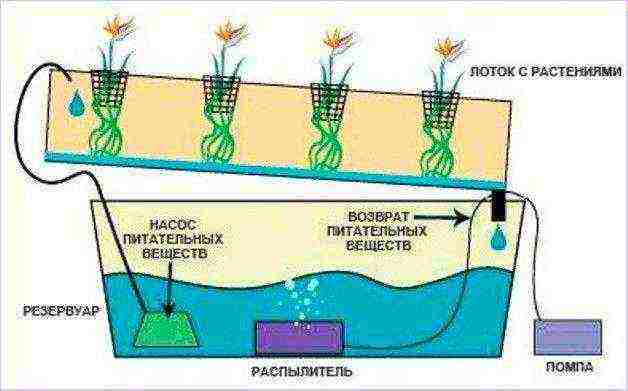
Hydroponics scheme N.F.T.
- DeepWaterCulture aquaponics is not the most suitable way to produce strawberries. Here, problems arise in the growth of the culture due to the constantly immersed roots in the solution. The bushes are placed in pots of expanded clay and fixed in the lid of a reservoir with a nutrient solution or on the surface of a floating foam.To provide the roots with oxygen, air is supplied to the nutrient liquid by a powerful 150 l / h compressor. There are several downsides to this kind of cultivation:
- excessive moisture;
- lack of clear control of nutrient intake;
- frequent replacement of the solution;
- use of a large area.

Growing on floating foam
- Method of aeroponics. This artificial fogging is generated by a generator. The roots of the plant are embedded in rock wool and feed on substances from the sprayed mist. With this irrigation, all the nutrients are absorbed much better.

Aeroponic root feeding
- Batch flooding system EBB / Flow. Special timers ensure the frequency of immersion of the root system in the nutrient solution. The root part can be located both in an empty container and in a moisture-absorbing material that is regularly filled with an aqueous solution. The advantage is that the regular inflow and outflow of fluid does not give a chance for the accumulation of excess salts on the roots. The main disadvantage is the rapid drying of the root if the pump fails.
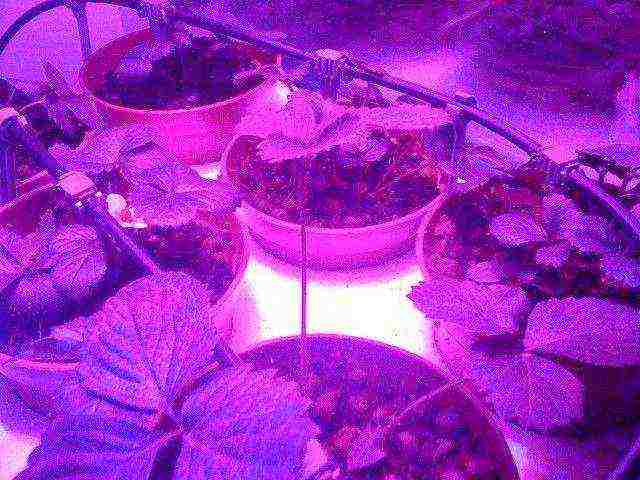
Intermittent flooding system
How to prepare seedlings
Seedlings are purchased in the nursery or taken from the open ground of their own area. Harvesting is done at the end of the summer period or at the beginning of autumn.
Tip: Before planting seedlings in the basement, it must be placed in the cold for a certain time. This will lead to the process of stopping the life of the bushes, as in the winter season. Cooling down for a while is the most important thing in growing strawberries in the basement. A suitable place to hibernate is a freezer.
The best method for setting up your first plantings is by sowing seeds.

The first shoots of strawberries from seeds
They are sown in small boxes, in pre-moistened soil, and slightly covered with earth. The germination quality of strawberry seeds is low, about 50%.
Therefore, the main requirements for seed germination are:
- The presence of bright sunlight.
- Maintaining high moisture content of the soil surface.
Tip: You need to moisten the soil with a sprayer, this prevents soil erosion.
After the first shoots appear, they are allowed to take root well. Then the first pick is carried out, for this, the seedlings are staggered every five centimeters.
After 1.5 months of seedling growth, a second pick is carried out. Strawberries are planted already in rows with a step of 10 centimeters. As a result, a sufficient number of mother bushes close to budding grows. In the second year, planting material is obtained with the help of young grafted rosettes. For high yields, all strawberry beds must be renewed every year.
As you can see, growing strawberries is not a tough job. If the best conditions for its cultivation are created, and the process is fully automated, then the end result is guaranteed success - a bountiful and very tasty harvest is collected. This video provides an opportunity to get acquainted in detail with the latest technologies involved in obtaining a delicious berry.
You will be interested in:
- Growing mushrooms in the basement: technology secrets
- Growing crayfish in the basement: what's best
- Rabbits in the cellar: how to properly keep
We are accustomed to the fact that it is customary to grow vegetables either in the open field - where climatic conditions permit, or in greenhouses. And few people come to mind that there is another method, proven over the years: growing vegetables underground.
Meanwhile, this method is far from new - back in 1875, the first experiments on growing vegetables in the basement were carried out. This "experimental area" was illuminated with ordinary kerosene lamps and gas burners. And the result shocked both the experimenters themselves and everyone who knew about this experiment. During the year, 180 kg of tomatoes from 1 m2 were harvested in this underground garden! When grown outdoors, such results could only be dreamed of!
So what does it take to grow a good crop underground?
WE CHOOSE A ROOM
Almost any basement or cellar can be used as an "underground greenhouse" - after all, the air temperature, its chemical composition and atmospheric pressure in such a dungeon practically do not differ from above ground ones.
But this is if you grow greens: sorrel, lettuce, dill, onions per feather. If you decide to go in for cucumbers and tomatoes, you will have to make additional efforts. First of all - in the organization of the light regime. "Underground days" should not exceed 18 hours. Cucumbers need 10 hours of light, tomatoes - 12.
The main expense when growing vegetables in the basement is electricity. But then there are no costs for the construction of a greenhouse. Moreover, you can grow vegetables in the basement at any time of the year. And if the basement is located under the house, then heating costs are excluded, even in the winter season.
LIGHTING
The best solution to the lighting problem is energy-saving lamps. Besides being economical, the air from this light source will not heat up. The power of the lamps per 2 m2 of the underground garden should be 11.2 kW / h.
FOOD
Growing vegetables underground with nutritious soil is not an option. Firstly, the very process of delivering a large amount of soil is very problematic, and secondly, it is easy to bring diseases and pests along with the soil.
The ideal solution is the hydroponic method. Quartz and granite gravel with a particle size of 520 mm is suitable for it. The plant will receive nutrients from a special solution.
SELECTING PLANTS AND VARIETIES
Good results are obtained by growing cucumbers and tomatoes in underground greenhouses.
Cucumbers must be chosen parthenocarpic, that is, self-pollinating. Tomatoes are early ripe with a short growing season.
On average, about 35 kg of tomatoes and about 60 kg of cucumbers are obtained from 1 m2 of greenhouses. But this, of course, is not the limit.
GROWING SEEDLING
The process of growing vegetables is divided into two stages: growing seedlings and growing fruit bearing plants.
A specially equipped area should be allocated for seedlings at the rate of 100 plants per 1 m2.
Four plants are placed in a permanent place per 1 m2.
On the seedling site, special waterproof trays are installed - they can be made from asbestos-cement pipes with a diameter of 50-60 cm sawn alongside. Gravel is poured into the trays with a layer of 20-22 cm.
Plant nutrition is carried out due to the nutrient solution, which is poured into a tank installed above the seedling containers by 0.1-1.5 m. The solution is fed by gravity, and then collected in a drain tank, which is installed below the bottom of the hydroponic trays. The trays are installed at a slope of 0.3 °.
The nutrient-rich used solution is pumped back into the feed tank and reused. Plant feeding is carried out once every four light cycles, always during the light period.
The essential components of the nutrient mixture are nitrogen, phosphorus, potassium, calcium, magnesium.
Depending on the phase of plant development, the ratio of elements changes.
The nutritional mixture must also include trace elements: manganese, boron, zinc, copper.
Cucumbers and tomatoes should be watered once every 5-6 days with a solution of sodium humate at a concentration of 0.005%. This measure increases the yield and also promotes desalinization of the substrate.
Is sheepskin worth making?
Many people reject the idea of growing vegetables underground for one simple reason: they believe that it is impossible to grow "real", natural vegetables without natural light. The answer can be given by a chemical analysis of the fruits grown in the basement.
The main indicator of the quality of vegetables is the presence of vitamins in them. As the analysis shows, vitamin C in "underground" cucumbers is several times more than in ordinary ones. The same - with cabbage and onions. In addition, the cucumbers from the basement are much sweeter than the ground ones.
By the way, underground vegetables develop much faster than their ground counterparts. For example, seedlings of cucumbers in greenhouses are ready for planting in 30-35 days, and underground - a week earlier.
source
Table of contents:
- Equipment for underground gardens
- Basement gardening
The planet's population is gradually increasing, although the planet itself is no longer becoming. This means that it is necessary to use every square meter of land as efficiently as possible. In the field of construction, humanity is showing incredible achievements not only in the beauty and architectural uniqueness of buildings. The Empire State Building has held the palm among high-rise buildings for almost forty years. Then 102 floors seemed to be something unsurpassed. Since then, skyscrapers have been growing like mushrooms, and some of them even provide a place where flowers, and maybe mushrooms, too. For example, the greenhouse "Pasona O2" grows gorgeous flowers, and it is located in the basement of a Tokyo office skyscraper.

The composition of the compost for mushrooms.
But we don't have the luxury of a skyscraper basement in downtown Tokyo. Therefore, we will try to effectively use the space available to us, namely, the basement or cellar of an ordinary house. We will not call such premises ideal for placing greenhouses and greenhouses in them, but they still have some advantages:
- protected from external adverse weather influences (hail, fog, frost, etc.);
- it is technically easy to maintain the required microclimate;
- low heating costs in winter (in summer it does not require any costs to maintain the temperature regime).
An interesting fact is that greens and vegetables grown in basements and cellars are in no way inferior to their relatives grown in open ground. Moreover, laboratory studies have proven that onions grown under artificial light contain several times more vitamin C, because this vitamin is destroyed in the sun. Better quality and "underground" cucumbers - they are more sugar-rich.
Equipment for underground gardens
Basements, cellars or underground workings can be adapted for greenhouse needs. It will be easier to equip a room if you know that:

The scheme of development of the fruiting body of champignons.
- Good ventilation is the first and prerequisite for a successful indoor garden. Ventilation windows should be covered with fine mesh to prevent pests from entering the room.
- If in a cellar or basement the walls and floor are made of concrete - not bad, this is fine. To protect the premises from the formation of mold and other harmful microorganisms, the walls must be whitewashed with lime.
As a light source, conventional incandescent lamps, mercury arc lamps, sodium, fluorescent or xenon lamps are currently used.
Conventional incandescent bulbs cannot provide enough light for the photosynthesis process.
Therefore, they can only be used in combination with other types of lamps. It is ideal to use specialized lamps - phytolamps, the spectrum of light emitted by them is most suitable for optimal plant growth and the process of photosynthesis.
If the cultivation of products involves the use of a substrate, then the room should be equipped with special racks or shelves for boxes. For the hydroponic method, you need to equip the room with waterproof seedling trays and tanks for the nutrient mixture.
Back to the table of contents
Basement gardening 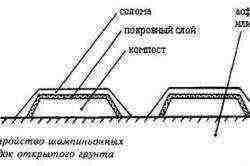
Layer diagram of champignon beds.
Rest assured that you can grow a good crop of greens, mushrooms, or vegetables in your basement. Growing mushrooms in the basement, namely champignons, oyster mushrooms and even white mushrooms, will surprise no one. For this type of product, it will be necessary to equip shelves with boxes. 5-7 kg of mycelium or 1 liter per 1.5 m² are required per ton of substrate. You can buy a prepared substrate with mycelium in bags.This is the cleanest way of growing mushrooms, because it is on these bags that they grow - the substrate does not crumble, everything is clean and tidy.
It has been proven by many years of practice that at home in the basement or cellar, amateur gardeners successfully grow onions for feathers, lettuce, dill and parsley, cucumbers and tomatoes traditional for our cuisine. They practice both growing on a substrate and using a hydroponic method. Bringing in the substrate is a rather laborious process. Maybe that's why the hydroponics method is gaining popularity. In this case, you will need to stock up on crushed stone of a fraction of 5-20 mm - this will serve as the basis for the "bed". Liquid will be supplied from the tank with the nutrient mixture to the plant roots. For effective growth and full-fledged photosynthesis, it is necessary to supply the nutrient mixture during the light period every 4-5 days. The food is fed by gravity, then collected in a sump, from where it is fed back to the feed tank.
For growing vegetables in basements and cellars, varieties with the shortest growing season are chosen. First you need to grow the seedlings, and then transplant them to a permanent place of growth. Seedlings are grown at the rate of 100 pcs. for 1 m². You need to plant seedlings 4 plants per 1 m².
Keep in mind that all processes in underground greenhouses take place a week earlier. That is, the first ripe tomatoes will appear a week earlier than they would have ripened in a traditional greenhouse.
"Day" under the ground have their own parameters:
- duration - 18 hours;
- daylight hours for cucumbers - 10 hours;
- daylight hours for tomatoes - 12 hours.
Think about what you can grow in the conditions available to you. Growing produce in a basement is a very fun process, if not a carefree one. Try it and you will succeed. It is only at first glance difficult, in fact: the eyes are afraid - the hands are doing. Good luck and good harvest.
